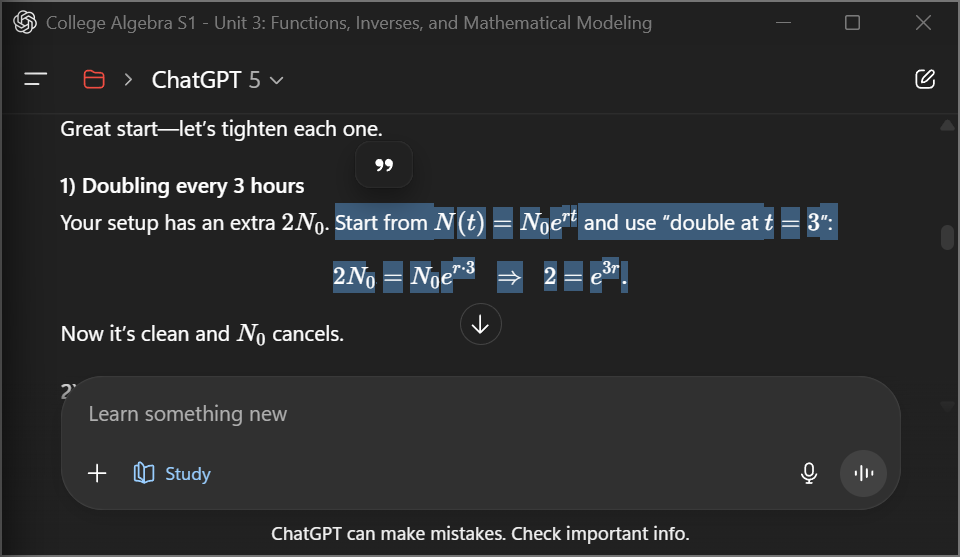MA116 Unit 3: Factoring, Inverses, Mathematical Modeling
1/12
Name | Mastery | Learn | Test | Matching | Spaced |
|---|
No study sessions yet.
13 Terms
If one code gives two different snacks, is it a function? (Yes/No)
No, because a function must have one input for each output
If a graph fails the horizontal line test, can it have an inverse that’s a function? (Yes/No)
No, if a graph fails the horizontal test. It is not 1-to-1; therefore, it is not a function, so it can’t have an inverse that’s a function.
Why do we need one-to-one to have an inverse function? (one sentence)
You need a 1-to-1 so that you know which function the graph is coming from. Two same inputs/outputs you wouldn’t know
If f’s range is (0, ∞), what’s domain of f⁻¹?
flip which end is smaller — intervals always go left to right:
→ Domain of f⁻¹ = (0, ∞).
(The swap is domain ↔ range, but orientation stays increasing left→right.)
Is log(x − 3) defined at x = 2?
No, because it would be log(−1).
If h(x) passes the vertical line test but fails the horizontal line test, what must you do before finding an inverse function for h?
we restrict its domain so that each x gives a unique y.

If a bacteria culture doubles every 3 hours, what’s the growth rate r in N = N₀ e^{r t}?
our setup has an extra 2N0 Start from N(t)= N0ert and use “double at t=3t=3t=3”:
2N0=N0er⋅3 ⇒ 2=e3r.2N_0 = N_0 e^{r\cdot 3}\;\;\Rightarrow\;\; 2 = e^{3r}.2N0=N0er⋅3⇒2=e3r.
If something decays by 5 % each hour, how much remains after 10 hours?
Your form N=N0e−0.05⋅10N = N_0 e^{-0.05\cdot 10}N=N0e−0.05⋅10 is perfect if you’re modeling a continuous 5% rate.
(If it were “5% off each hour, step-by-step,” that’d be N=N0(0.95)10N=N_0(0.95)^{10}N=N0(0.95)10. Both are common; they’ll give close answers.)

Solve
10^𝑥=250
Log(250)=2.40
how do you do row2 on calc?
2nd, Matrix—> Math B: go back and insert matrix that you previously made
Find the inverse of \sqrt{1+x}
\sqrt{1+x},x=\sqrt{1+y,}x^2=1+y,y=x^2-1,f^{-1}\left(x\right)=x^2-1
find the inverse off(x)=\frac{1}{x}-2.
y=1/x−2
Swap x and y: x=1/y−2
solve like algebra, manipulate to get y- x+2=1/y
f^−1(x)=1/x+21